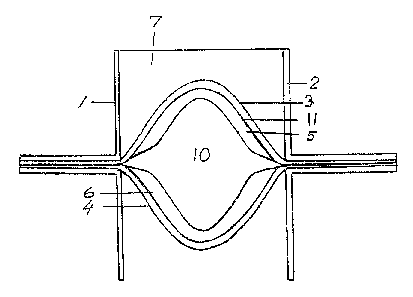Une partie des informations de ce site Web a été fournie par des sources externes. Le gouvernement du Canada n'assume aucune responsabilité concernant la précision, l'actualité ou la fiabilité des informations fournies par les sources externes. Les utilisateurs qui désirent employer cette information devraient consulter directement la source des informations. Le contenu fourni par les sources externes n'est pas assujetti aux exigences sur les langues officielles, la protection des renseignements personnels et l'accessibilité.
L'apparition de différences dans le texte et l'image des Revendications et de l'Abrégé dépend du moment auquel le document est publié. Les textes des Revendications et de l'Abrégé sont affichés :
| (12) Brevet: | (11) CA 2148937 |
|---|---|
| (54) Titre français: | ELEMENT DE JOINT DE DILATATION |
| (54) Titre anglais: | DILITATION JOINT ELEMENT |
| Statut: | Durée expirée - au-delà du délai suivant l'octroi |
| (51) Classification internationale des brevets (CIB): |
|
|---|---|
| (72) Inventeurs : |
|
| (73) Titulaires : |
|
| (71) Demandeurs : |
|
| (74) Agent: | SMART & BIGGAR LP |
| (74) Co-agent: | |
| (45) Délivré: | 2004-09-14 |
| (86) Date de dépôt PCT: | 1993-11-09 |
| (87) Mise à la disponibilité du public: | 1994-05-26 |
| Requête d'examen: | 2000-10-24 |
| Licence disponible: | S.O. |
| Cédé au domaine public: | S.O. |
| (25) Langue des documents déposés: | Anglais |
| Traité de coopération en matière de brevets (PCT): | Oui |
|---|---|
| (86) Numéro de la demande PCT: | PCT/SE1993/000948 |
| (87) Numéro de publication internationale PCT: | SE1993000948 |
| (85) Entrée nationale: | 1995-05-08 |
| (30) Données de priorité de la demande: | ||||||
|---|---|---|---|---|---|---|
|
To avoid leakage in concrete structures with dilatation joints and to prevent
dirt from accumulating in the joints there has
been developed a dilatation joint element which is easy to mount, reliable and
essentially maintenance-free. The dilatation joint
element according to the invention is comprised of opposed, longitudinal angle
elements (1, 2) interconnected in pairs and made
of metal with interposed jointing compound (7), reinforcement bands (3, 4) and
rubber elements (5, 6). With curved band sections
and rubber elements between the angle elements and a curved jointing compound
section which is attached to the upper band
section there is provided a supporting, power-compensating and power-
distributing function when the joint is subjected to load, both
at compression, expansion and shearing, providing a tight, reliable and
loadable joint with good fatigue strength.
Note : Les revendications sont présentées dans la langue officielle dans laquelle elles ont été soumises.
Note : Les descriptions sont présentées dans la langue officielle dans laquelle elles ont été soumises.

2024-08-01 : Dans le cadre de la transition vers les Brevets de nouvelle génération (BNG), la base de données sur les brevets canadiens (BDBC) contient désormais un Historique d'événement plus détaillé, qui reproduit le Journal des événements de notre nouvelle solution interne.
Veuillez noter que les événements débutant par « Inactive : » se réfèrent à des événements qui ne sont plus utilisés dans notre nouvelle solution interne.
Pour une meilleure compréhension de l'état de la demande ou brevet qui figure sur cette page, la rubrique Mise en garde , et les descriptions de Brevet , Historique d'événement , Taxes périodiques et Historique des paiements devraient être consultées.
| Description | Date |
|---|---|
| Inactive : Périmé (brevet - nouvelle loi) | 2013-11-09 |
| Inactive : Lettre officielle | 2005-05-18 |
| Accordé par délivrance | 2004-09-14 |
| Inactive : Page couverture publiée | 2004-09-13 |
| Préoctroi | 2004-06-23 |
| Inactive : Taxe finale reçue | 2004-06-23 |
| Lettre envoyée | 2004-02-05 |
| Un avis d'acceptation est envoyé | 2004-01-14 |
| Lettre envoyée | 2004-01-14 |
| Un avis d'acceptation est envoyé | 2004-01-14 |
| Inactive : Correspondance - Transfert | 2004-01-08 |
| Inactive : Approuvée aux fins d'acceptation (AFA) | 2004-01-06 |
| Inactive : Lettre officielle | 2003-12-08 |
| Lettre envoyée | 2003-11-27 |
| Lettre envoyée | 2003-11-27 |
| Exigences de rétablissement - réputé conforme pour tous les motifs d'abandon | 2003-11-18 |
| Modification reçue - modification volontaire | 2003-11-18 |
| Réputée abandonnée - omission de répondre à un avis sur les taxes pour le maintien en état | 2003-11-10 |
| Inactive : Transfert individuel | 2003-10-08 |
| Inactive : Dem. de l'examinateur par.30(2) Règles | 2003-05-28 |
| Lettre envoyée | 2002-04-23 |
| Lettre envoyée | 2002-04-23 |
| Lettre envoyée | 2002-04-23 |
| Inactive : Transfert individuel | 2002-02-28 |
| Lettre envoyée | 2000-12-06 |
| Inactive : Renseign. sur l'état - Complets dès date d'ent. journ. | 2000-12-05 |
| Inactive : Dem. traitée sur TS dès date d'ent. journal | 2000-12-05 |
| Exigences pour une requête d'examen - jugée conforme | 2000-10-24 |
| Toutes les exigences pour l'examen - jugée conforme | 2000-10-24 |
| Demande publiée (accessible au public) | 1994-05-26 |
| Date d'abandonnement | Raison | Date de rétablissement |
|---|---|---|
| 2003-11-10 |
Le dernier paiement a été reçu le 2004-08-16
Avis : Si le paiement en totalité n'a pas été reçu au plus tard à la date indiquée, une taxe supplémentaire peut être imposée, soit une des taxes suivantes :
Les taxes sur les brevets sont ajustées au 1er janvier de chaque année. Les montants ci-dessus sont les montants actuels s'ils sont reçus au plus tard le 31 décembre de l'année en cours.
Veuillez vous référer à la page web des
taxes sur les brevets
de l'OPIC pour voir tous les montants actuels des taxes.
Les titulaires actuels et antérieures au dossier sont affichés en ordre alphabétique.
| Titulaires actuels au dossier |
|---|
| TREMCO, INCORPORATED |
| INTERMERC KB |
| Titulaires antérieures au dossier |
|---|
| OLOF ALMSTROM |